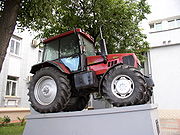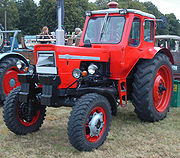.gif)
Belarus (tractor)
Encyclopedia


Tractor
A tractor is a vehicle specifically designed to deliver a high tractive effort at slow speeds, for the purposes of hauling a trailer or machinery used in agriculture or construction...
s produced since 1950 at the Minsk Tractor Plant, MTZ (Мінскі трактарны завод; Ми́нский тра́кторный заво́д, МТЗ) in Minsk
Minsk
- Ecological situation :The ecological situation is monitored by Republican Center of Radioactive and Environmental Control .During 2003–2008 the overall weight of contaminants increased from 186,000 to 247,400 tons. The change of gas as industrial fuel to mazut for financial reasons has worsened...
, Belarus
Belarus
Belarus , officially the Republic of Belarus, is a landlocked country in Eastern Europe, bordered clockwise by Russia to the northeast, Ukraine to the south, Poland to the west, and Lithuania and Latvia to the northwest. Its capital is Minsk; other major cities include Brest, Grodno , Gomel ,...
.
These tractors are very well known throughout the former Soviet Union
Soviet Union
The Soviet Union , officially the Union of Soviet Socialist Republics , was a constitutionally socialist state that existed in Eurasia between 1922 and 1991....
, and have been exported to the Eastern Bloc
Eastern bloc
The term Eastern Bloc or Communist Bloc refers to the former communist states of Eastern and Central Europe, generally the Soviet Union and the countries of the Warsaw Pact...
, as well as other countries (even to the United States
United States
The United States of America is a federal constitutional republic comprising fifty states and a federal district...
).
Belarus supplies 11% of the world's tractors.
History
At the end of World War II, agricultural infrastructure in the Soviet Union (USSR) was in a poor state, production of agricultural machinery having been non existent during the later years of the War. Those tractors and machinery still working on the Large Collective Farms were tired from heavy use and also dated, most having been produced in the early 1930's or earlier. At best these tractors were unreliable and were poorly maintained. The Communist state ordered new tractors to be made at several locations within the USSR, the main assembly plant for MTZ being in Minsk, Belarus, with smaller tractors being produced in other locations, while other factories produced high HP articulated & tracked tractors. All these tractors were exported under the name "Belarus" but were of a different design to each other.Within the Eastern bloc the tractors had no paint scheme, They were simply painted the same colour all over, red, green and blue being the most common. In the late 80's Belarus tractors gained a paint livery of cream/white, cream wheels, with a red chassis, this remained until the late 1990s when it changed to red with a black chassis and cream wheels (later silver).
A green alternative to the red was available for some markets during the early 2000s. While blue with a black chassis is currently the livery for the more basic 2wd cabless models.
Up to the 1950s MTZ had not produced wheeled tractors, tracked crawler tractors being more common. These early tractors were essentially re-claimed tanks, with the gun turret removed and a flatbed, winch, crane or dozer blade added, the tractors seeing more use on land reclamation and forestry applicaions rather than agriculture. This was largely due to the tanks being unsuitable for large scale culitivation as their engine, transmission and track reliability was poor due to them not being designed for pulling loads for long periods as required in agriculture. New designs were put into production during 1950 and the new MTZ wheeled tractor was born. These tractors were built to the three main concepts of Soviet engineering- reliability, simplicity and value for money.
During the cold war, Belarus gained a poor reputation, partially due to Western propaganda, but also the quality of the tractors often suffered due to the then Communist State stopping investment, to concentrate on weapons and military output. Often the tractor factories could not obtain quality materials and made-do with inferior components. The quality of rubber seals, gaskets and paint was particularly poor in the early 1990s. The Belarus name suffered much during this time, but with more investment in the late 1990s-2000s the name has bounced back, and now offer a high quality product that meets European standards.
Some 3 million tractors have been built in the Minsk tractor works since 1948.
Mechanical description
MTZ tractors were originally designed for the vast State owned collective farms of the USSR, situated in the most inhospitable areas of Eastern Europe these collectives extended over many thousands of acres and had little in the way of workshop tools and spare parts. The tractors were built in such a way that even a novice could get the tractor working again with only basic instruction.The air filter was of a washable oil bath type, the centrifugal Engine oil filter only required washing out rather than replacing, whilst the hydraulic and fuel filters were also of a washable design until the 1990s.
Until recently the tractors had either an air or liquid cooled engine with a 4 cylinder diesel being the most common configuration, while larger 6 cylinder and articulated models were available.
A variety of methods were used to start the engines depending on the model. A 24 volt electric starter motors was most common on export models and for use in less rural locations where replacement batteries were more easily obtainable. A diesel, kerosene or petrol 2 stroke starting engine was more common in the Eastern bloc countries due to them being more reliable in the colder winters and batteries being expensive or simply unobtainable.
Various adaptations to the tractor have also been made to aid starting in cold weather, including a lever to disconnect the hydraulic pump.
The three-point hitch is operated by a hydraulic cylinder, and is one of the few tractor designs that can apply "Down Pressure" with the three-point hitch.
The design of the tractors has changed much since the 1990s. Since the fall of the Soviet Union in 1991 MTZ-Belarus tractors have become more complex and more advanced, mainly due to imported Western built tractors becoming serious competitors, so MTZ had to compete for the market and modify their designs accordingly. In the past MTZ had paid little attention to cosmetic appearance and operator comfort, but recently these have become more important, however for certain markets a basic tractor is still available. These models are much the same as the tractors of the 1970s and have little in the way of comfort and extras such as power steering. There still remains a market for this type of tractor and Belarus remains the first choice for buyers looking for a basic & simple machine.

